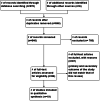Laparoscopic surgery during the COVID-19 pandemic: detection of SARS-COV-2 in abdominal tissues, fluids, and surgical smoke
- PMID: 33675407
- PMCID: PMC7936592
- DOI: 10.1007/s00423-021-02142-8
Laparoscopic surgery during the COVID-19 pandemic: detection of SARS-COV-2 in abdominal tissues, fluids, and surgical smoke
Abstract
Background: There are still concerns over the safety of laparoscopic surgery in coronavirus disease 2019 (COVID-19) patients due to the potential risk of viral transmission through surgical smoke/laparoscopic pneumoperitoneum.
Methods: We performed a systematic review of currently available literature to determine the presence of severe acute respiratory syndrome coronavirus 2 (SARS-COV-2) in abdominal tissues or fluids and in surgical smoke.
Results: A total of 19 studies (15 case reports and 4 case series) comprising 29 COVID-19 patients were included. The viral RNA was positively identified in 11 patients (37.9%). The samples that tested positive include the peritoneal fluid, bile, ascitic fluid, peritoneal dialysate, duodenal wall, and appendix. Similar samples, together with the omentum and abdominal subcutaneous fat, tested negative in the other patients. Only one study investigated SARS-COV-2 RNA in surgical smoke generated during laparoscopy, reporting negative findings.
Conclusions: There are conflicting results regarding the presence of SARS-COV-2 in abdominal tissues and fluids. No currently available evidence supports the hypothesis that SARS-COV-2 can be aerosolized and transmitted through surgical smoke. Larger studies are urgently needed to corroborate these findings.
Keywords: COVID-19; Surgery; Surgical smoke.
Conflict of interest statement
The authors declare no competing interests.
Figures
Similar articles
-
SARS-Cov-2 Was Not Found in the Peritoneal Fluid of an Asymptomatic Patient Undergoing Laparoscopic Appendectomy.Surg Laparosc Endosc Percutan Tech. 2020 Dec;30(6):e43-e45. doi: 10.1097/SLE.0000000000000837. Surg Laparosc Endosc Percutan Tech. 2020. PMID: 32694404 Free PMC article.
-
Risk of Virus Contamination Through Surgical Smoke During Minimally Invasive Surgery: A Systematic Review of the Literature on a Neglected Issue Revived in the COVID-19 Pandemic Era.Eur Urol Focus. 2020 Sep 15;6(5):1058-1069. doi: 10.1016/j.euf.2020.05.021. Epub 2020 Jun 5. Eur Urol Focus. 2020. PMID: 32527624 Free PMC article.
-
Abdominal Surgery in Patients With COVID-19: Detection of SARS-CoV-2 in Abdominal and Adipose Tissues.Ann Surg. 2020 Sep 1;272(3):e253-e256. doi: 10.1097/SLA.0000000000004165. Ann Surg. 2020. PMID: 32568751 Free PMC article.
-
Transmission of SARS-CoV-2 in Surgical Smoke during Laparoscopy: A Prospective, Proof-of-concept Study.J Minim Invasive Gynecol. 2021 Aug;28(8):1519-1525. doi: 10.1016/j.jmig.2020.12.026. Epub 2020 Dec 26. J Minim Invasive Gynecol. 2021. PMID: 33373728 Free PMC article.
-
How can we minimize the potential risk of viral contamination during laparoscopic procedures for suspected or infected COVID-19 patients?Eur J Obstet Gynecol Reprod Biol. 2020 Dec;255:63-66. doi: 10.1016/j.ejogrb.2020.10.011. Epub 2020 Oct 16. Eur J Obstet Gynecol Reprod Biol. 2020. PMID: 33086141 Free PMC article. Review.
Cited by
-
Impact of COVID-19 Outbreak on Stoma Surgery and Stoma Clinic Service: A Retrospective Study at a Single Japanese Referral Hospital.Int J Clin Pract. 2022 Aug 4;2022:4789775. doi: 10.1155/2022/4789775. eCollection 2022. Int J Clin Pract. 2022. PMID: 36016825 Free PMC article.
-
Comparison of surgical smoke between two approaches for endoscopic thyroidectomy and open thyroidectomy.BMC Surg. 2022 Dec 8;22(1):420. doi: 10.1186/s12893-022-01870-y. BMC Surg. 2022. PMID: 36482383 Free PMC article.
-
Presence of SARS-CoV-2 in abdominal tissues and biologic fluids during abdominal surgery: a systematic review.Surg Endosc. 2023 Jul;37(7):5011-5021. doi: 10.1007/s00464-023-10130-w. Epub 2023 May 23. Surg Endosc. 2023. PMID: 37219799 Free PMC article.
-
[Impact of COVID-19 on elective and emergency colorectal surgery].Chirurg. 2021 Oct;92(10):924-928. doi: 10.1007/s00104-021-01464-z. Epub 2021 Jul 13. Chirurg. 2021. PMID: 34258647 Free PMC article. Review. German.
-
Smoke analysis of a new surgical system that applies low-temperature plasma.Ann Transl Med. 2022 Oct;10(19):1053. doi: 10.21037/atm-22-608. Ann Transl Med. 2022. PMID: 36330412 Free PMC article.
References
-
- Society of American Gastroenterological and Endoscopic Surgeons (SAGES), European Association for Endoscopic Surgery (EAES). SAGES and EAES recommendations regarding surgical response to COVID-19 crisis [Internet]. SAGES. 2020 [cited 2020 Jul 25]. Available from: https://www.sages.org/recommendations-surgical-response-covid-19/
-
- Di Saverio S, Khan M, Pata F, Ietto G, De Simone B, Zani E, et al. Laparoscopy at all costs? Not now during COVID-19 outbreak and not for acute care surgery and emergency colorectal surgery: a practical algorithm from a hub tertiary teaching hospital in Northern Lombardy, Italy. J Trauma Acute Care Surg. 2020;88(6):715–718. doi: 10.1097/TA.0000000000002727. - DOI - PMC - PubMed
-
- Angioni S (2020) Laparoscopy in the coronavirus disease 2019 (COVID-19) era. Gynecol Surg [Internet]. [cited 2020 Jul 25];17(1). Available from: https://www.ncbi.nlm.nih.gov/pmc/articles/PMC7224160/ - PMC - PubMed
-
- Wu Y, Guo C, Tang L, Hong Z, Zhou J, Dong X, Yin H, Xiao Q, Tang Y, Qu X, Kuang L, Fang X, Mishra N, Lu J, Shan H, Jiang G, Huang X. Prolonged presence of SARS-CoV-2 viral RNA in faecal samples. Lancet Gastroenterol Hepatol. 2020;5(5):434–435. doi: 10.1016/S2468-1253(20)30083-2. - DOI - PMC - PubMed
Publication types
MeSH terms
Substances
LinkOut - more resources
Full Text Sources
Other Literature Sources
Medical
Miscellaneous


